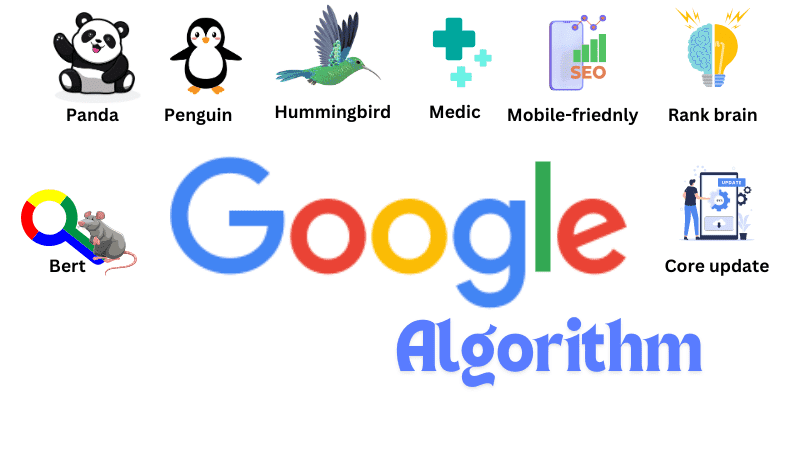Here are the ten Google algorithm updates that have permanently altered SEO over the previous decade.
Google promises to improve its search algorithm thousands of times per year. In the vast majority of cases, Google algorithm modifications are too minor to notice. However, every now and then, Google makes a major update that permanently alters the way we do SEO.
In this essay, we will list eight of the most important search algorithm updates. We will investigate why these upgrades were implemented, how they work, and what changes we needed to make to our SEO tactics in response.
But, before we begin, let’s examine if you’ve ever been affected by an algorithm modification. All you need to do is launch Rank Tracker, connect it to your Google Analytics account, and select Organic Traffic.
Simply hover your mouse over the graph’s dash lines to observe if particular algorithm updates correspond to changes in traffic to your site.
- Panda
Date: February 24, 2011
Issues: Duplicate, plagiarized or thin content; user-generated spam; keyword stuffing.
How it works: The Panda algorithm update assigns a “quality score” to web sites. This score is then utilized as a ranking element. Panda’s impacts were mild at first, but in January 2016, it was permanently incorporated into Google’s core algorithm. Since then, update rollouts have increased in frequency, resulting in speedier Panda penalties and recoveries.
- Penguin
Date: April 24, 2012
Issues: Spammy or irrelevant links; links with over-optimized anchor text.
How it works: Google Penguin’s goal is to penalize sites with artificial backlinks. This update put a stop to low-effort link building, such as purchasing links from link farms and PBNs.
- Hummingbird
Date: August 22, 2013
Issues: Keyword stuffing; low-quality content.
How it works: The Hummingbird algorithm assists Google in better interpreting search queries and returning results that are more relevant to the searcher’s intent. While keywords remain crucial, the Hummingbird algorithm allows a page to rank for a query even if it does not contain the precise terms the searcher input. This is accomplished through the use of natural language processing, which depends on latent semantic indexing, co-occurring phrases and synonyms.
- Mobile
Date: April 21, 2015
Issues: Lack of a mobile version of the page; poor mobile usability.
How it works: This, along with later mobile search improvements (2018, 2020), changed the focus of your website from desktop to mobile. Today, Google ranks all websites according to how quick and user-friendly their mobile versions are.
- RankBrain
Date: October 26, 2015
Issues: Lack of query-specific relevance; shallow content; poor UX.
How it works: RankBrain is a component of Google’s Hummingbird algorithm. It is a machine learning algorithm that assists Google in understanding the meaning of searches and providing the most relevant search results in response. Google ranks RankBrain as the third most important ranking component.
While we don’t know the actual algorithm behind this huge improvement, the general belief is that RankBrain is in charge of tailoring a user’s Google search results. Basically, Google looks beyond a person’s search query and considers the greater context, such as synonyms, implied phrases, and personal search history.
- Medic
Date: May 4, 2018
Issues: Lack of authority on YMYL websites; weak E-A-T signals.
How it works: The Google Medic change appeared to disproportionately effect medical websites, as well as other websites dealing with potentially life-changing decisions (financial, legal, education). Although not expressly verified, Google staff have hinted that the upgrade included some of the E-A-T (expertise, authority, and trust) signals outlined in the Quality Rater Guidelines page.
- Bert
Date: October 22, 2019
Issues: Poorly written content; lack of focus; lack of context.
How it works: This Google algorithm upgrade makes use of natural language processing technology to improve understanding of search queries, text interpretation, entity identification, and entity relationships. Panda, Hummingbird, and RankBrain upgrades have all moved away from keywords, and the BERT update is the pinnacle of that effort, allowing Google to understand far more detail in both queries and search results.
- Core Updates
Date: 2017-present
How it works: Since 2017, Google has referred to larger updates as Google core updates. Since then, there has been even less transparency about what those upgrades are and which aspects of search they are designed to enhance. SEOs frequently track post-update ranking movements to determine what exactly has changed, but there is rarely a definite observation. Google core updates are most likely just improvements to earlier Google updates, although they could be bundles of smaller updates coupled together.
FAQ
What is Google’s latest algorithm?
On September 14, 2023, Google began rolling out its most recent algorithm upgrade, known as the “September 2023 Helpful Content Update.” This version includes a “improved classifier” and is expected to take around two weeks to completely implement.
What is the latest Google algorithm update 2024?
In March 2024, Google released one of its most significant core algorithm upgrades to date, giving many people fuel for thought. This update differs from earlier ones in that it focuses on low-quality, frequently AI-generated information that clutters search results.
Which are the major Google updates that have impacted SEO?
Here is a collection of the significant Google algorithm adjustments over the last ten years, along with a brief discussion of what each meant for webmasters and users.
- Caffeine (2010)
- Panda (2011)
- Penguin (2012)
- Venice (2012)
- Pirate (2012)
- Hummingbird (2013)
- Pigeon (2013)
- HTTPS/SSL (2014)
How many algorithm updates does Google make a year?
How often does Google alter its search algorithms? Google search is always evolving. In 2022, Google made 4,725 modifications to search, including changes to its ranking methods, user interface, and more. That means Google searches change on average 13 times per day.




